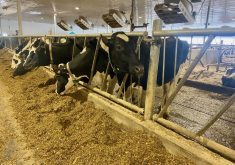Happy Father’s Day to all the dads on June 16.
When I was:
Four years old: my daddy can do anything.
Five years old: my daddy knows
a whole lot.
Six years old: my dad is smarter than your dad.
Eight years old: my dad doesn’t know everything.
Ten years old: In the olden days, when my dad grew up, things were sure
different.
Twelve years old: Oh well,
- aturally, Dad doesn’t know
Read Also

Powerful solar storm lights up night time sky
Prairie skywatchers have been on high alert the last few nights as spectacular aurora displays have made the night time…
anything about that. He is too
old to remember his childhood.
Fourteen years old: Don’t pay
any attention to my dad. He is so
old-fashioned.
Twenty-one years old: Him? My Lord, he’s hopelessly out of date.
Twenty-five years old: Dad knows about it, but then he should, because
he has been around so long.
Thirty years old: Maybe we should ask Dad what he thinks. After all,
he’s had a lot of
experience.
Forty years old: I wonder how Dad would have handled it. He
was so wise.
Fifty years old: I’d give anything if Dad were here now so I could talk
this over with him. Too bad I didn’t appreciate how smart he was. I
could have learned a lot from him.
– Writer unknown
The value of a pickle
Dear TEAM: I would like to know about the nutritional value of
cucumbers, fresh and pickled. I especially want to know about the
nutritional value of dill pickles. Are there health hazards involved in
eating pickles? – G.J., Gull Lake, Sask.
Dear G.J.: Cucumbers are low in calories, fat-free, sodium-free and a
source of vitamin C and folic acid in the diet. They are 96 percent
water, therefore are not as nutritious as other vegetables.
The nutritional value of 100 grams of raw and pared cucumber, about 12
slices, is: 10 calories, water 96 percent, carbohydrate two grams,
potassium 160 milligrams, calcium 18 mg, vitamin C 12 mg, iron 0.4 mg,
thiamin and riboflavin .02 mg, folic acid 16 micrograms, niacin two
niacin equivalents, a trace of fat, protein and vitamin A, and no
cholesterol. If the skins are eaten, iron content will be 1.2 mg.
Source: Health and Welfare Canada.
Pickled cucumbers
A fresh cucumber will have a higher nutritive content than a pickled
one. Pickles are processed in a liquid solution and, as in any cooking
of vegetables in a liquid, some of the water-soluble vitamins such as
vitamin C and folic acid will leave the cucumber and go into the
liquid. The smaller the pieces, the more surface area there will be for
nutrients to dissolve out. Therefore, a whole pickle will retain more
nutrients than sliced or chopped cucumber pickles.
The salt used in making pickles gives them a high salt content and
could be a problem for people on a restricted diet. Some pickle recipes
use sugar and other food that will change the nutritive values.
Improper home canning methods could be a health hazard. If in the
canning process the cucumbers do not reach a proper salt level,
pathogens could grow and cause illness. To avoid this, follow pickle
recipes exactly. Do not alter quantities of vinegar, vegetables or
fruits. Such changes can upset the acid balance and lead to food
spoilage. For pickling, use commercial vinegar, not homemade, with a
minimum five percent acidity.
Using up rhubarb
I received a delightful little cookbook with all kinds of recipes using
rhubarb. The cookbook is Rhubarb, more than just pies by Sandi Vitt and
Michael Hickman. It was published in 2000 by the University of Alberta
Press, Edmonton, and Hole’s of St. Albert, Alta. It can be purchased at
bookstores for $14.95. Royalties from the sale support the university’s
Devonian Botanic Garden.
Alberta lt.-gov. Lois Hole wrote the introduction and said that over
the years she learned that rhubarb is about more than just pies. She
said rhubarb is about perseverance, simple pleasures and memories of
spring. Because rhubarb is so easy to grow and flourishes all over the
place, should that make it of less value and the black sheep of the
garden?
The book has information on growing rhubarb, its nutritive value and
history. Here is a sample.
- Although rhubarb is a perennial, it won’t last forever. If left
alone, the crown will grow outward each year, leaving the centre
tissues to die and rot. A well-tended rhubarb plant will live up to 15
years, but most gardeners should replace their plants every seven to 10
years.
- Field tests in Brooks, Alta., found the Mcdonald variety of rhubarb
produces well coloured leaf stalks on vigorous plants and fine pie
fillings. Early Sunrise was another good choice, although less
vigorous, and Valentine was recommended for its bright-red stalks and
minimal seed-stalk growth. The Strawberry variety also performed well.
- Rhubarb stalks tend to develop a red colour when the growing
temperature is low and a green colour when temperature is high.
- When you pick rhubarb, pull the stalk cleanly from the crown. Don’t
cut it because that leaves the plant vulnerable to diseases and pests.
- Unless you are growing rhubarb for its ornamental value, cut off the
seed stalks that shoot up alongside the leaf stalk. The seed stalk
drains energy from the plants, reducing the food crop.
I have tried some of the 150 recipes in this book. Besides cobbler and
crisp recipes, there are soups, beverages, cakes, muffins, breads,
jams, sauces, condiments, salads and main dishes.
Pork chop-rhubarb casserole
6 pork chops, 1 inch
(2.5 cm) thick
1 tablespoon oil 15 mL
1 tablespoon butter 15 mL
salt, pepper, to taste
2 cups fine, fresh 500 mL
bread crumbs
1/2 cup sugar 125 mL
1/2 cup brown sugar 125 mL
3 tablespoons flour 45 mL
1/2 teaspoon cinnamon 2 mL
1/4 teaspoon salt 1 mL
6 cups rhubarb, 1.5 L
thinly sliced
Preheat oven to 350 F (180 C). Grease a shallow casserole. Trim fat
from chops. In a large, heavy skillet, quickly brown chops in oil and
butter and season with salt and pepper. Set them aside, then pour any
pan drippings over bread crumbs, mixing in with a fork.
Combine sugars, flour, cinnamon, salt and rhubarb. Sprinkle bottom of
casserole with half the bread crumbs, then cover with half of rhubarb
mixture. Place chops on top, then cover with the rest of the rhubarb
mixture, but not the remaining crumbs. Cover casserole tightly and bake
40 minutes. Remove cover, top with the rest of the bread crumbs and
bake another 10 minutes. Makes six servings.
Rhubarb bread
1 egg
1 cup honey 250 mL
1/2 cup butter, melted 125 mL
1/2 cup pineapple or 125 mL
orange juice
1 cup rhubarb, finely 250 mL
chopped
1/2 cup nuts, chopped 125 mL
21/2 cups flour 625 mL
2 teaspoons baking 10 mL
powder
1/2 teaspoon baking 2 mL
soda
1/2 teaspoon salt 2 mL
1/4 teaspoon ground 1 mL
ginger
Preheat oven to 350 F (180 C). Grease two smaller-sized loaf pans. In a
mixing bowl, beat the egg with the honey, melted butter and pineapple
or orange juice. Stir in the rhubarb and nuts.
In a separate bowl, sift together the flour, baking powder, baking
soda, salt and ginger. Combine dry ingredients with rhubarb mixture,
stirring just to mix. Pour the batter into prepared pans.
Bake 35 to 40 minutes or until the tops feel springy to the touch. Cool
bread in pans 10 minutes before removing to cool on a rack.
Rhubarb-strawberry soup
A tasty cold soup for a hot summer day. To me, a small serving will be
more appetizing than a big bowl of this soup.
1 cup rhubarb 250 mL
2 cups sliced 500 mL
strawberries
1/2 cup orange juice 125 mL
concentrate
1/2 cup water 125 mL
1/2 cup sugar 125 mL
2 teaspoons sherry 10 mL
sour cream and
strawberries for garnish
Put rhubarb, strawberries, orange juice, water and sugar into saucepan.
Bring to a boil. Simmer until cooked. Puree in a blender. Add sherry.
Chill.
Just before serving, place a dollop of sour cream in the centre of each
bowl and garnish with a strawberry slice. Make four to six servings.
Alma Copeland is a home economist from Rosetown, Sask., and one of four
columnists comprising Team Resources. Send correspondence in care of
this newspaper, Box 2500, Saskatoon, Sask., S7K 2C4.














